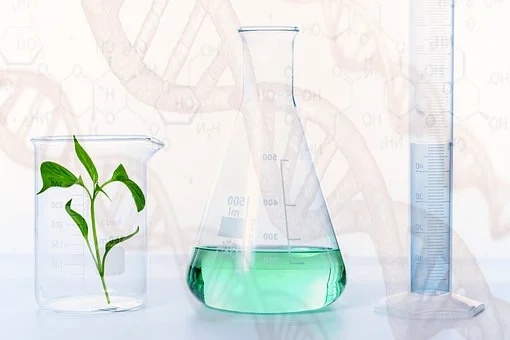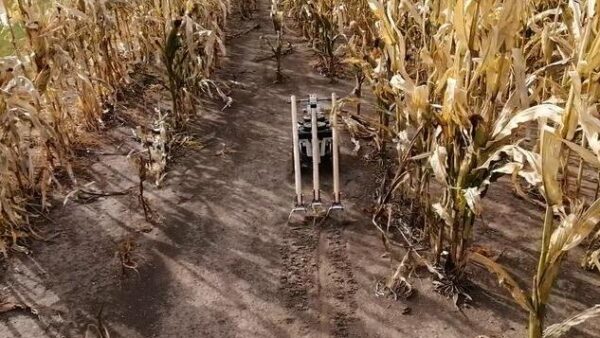Three experts share their perspective about major issues surrounding genetically modified crops.
Since the advent of genetically modified organisms decades ago, the debate about the technology and its risks or lack thereof hasn’t ebbed.
On one side, GMOs are said to hold promise for feeding a ballooning world population, for creating crops that can withstand a changing climate and that can reduce the need for the chemicals and fertilizers widely used on farm fields.
The other side questions the safety of GMO crops, saying they have never been properly tested. The opponents say the genetic characteristics of GMO crops are more about selling herbicides than saving the world and that we’re damaging the agricultural economy through cross contamination.
We talked to three biotechnology experts about the questions surrounding yield, sustainability, safety and adventitious presence, commonly known as contamination, of GMOs.
The Experts



YIELD
Michael Hansen
Hansen says he has yet to see genetically engineered crops that improve yields, despite promises of such when GMOs were first introduced. He notes a recently published National Academy of Sciences/National Research Council report stating “no significant changes in the rate at which crops yields increase could be discerned from the data,” and that “including such GE traits in policy planning as major contributors to feeding the world must be accompanied by strong caveats.”
Hansen points to work from Pennsylvania State University, recently reported in Nature, in which a conventional breeding technique led to the development of a common bean that takes in more phosphorus from soil and tripled yield in low nutrient soils, while genetic engineering has failed to produce such varieties.
“What they’re finding is they’re much more successful using conventional breeding, compared to genetic engineering,” Hansen says.
Mischa Popoff
Popoff says whether yield improves or not isn’t actually the point. Genetic engineering is a proven method for improving plants.
If population estimates of 9 billion people on Earth by 2050 don’t pan out, we will still have better crops that use fewer inputs and can withstand a changing climate.
“We just improve because it’s good to improve,” he says. “We don’t need a reason to improve. Improving efficiency is just inherently good.”
Kevin Folta
Folta says we haven’t seen consistently increased yields because companies haven’t had the need to develop those traits.
“We haven’t tested any genes associated with yield,” Folta says. “When people say ‘they haven’t improved yield,’ well, they’re not supposed to.”
He says the technology to improve yield is available, but American growers don’t have a need for improved yields, and he blames misguided activists for keeping those crops from developing countries that could use them. He points to cassava crops — that feed 1 billion people — that have been devastated by viruses.
“You can’t give away a crop that will help someone in the developing world because of activist pushback,” Folta says. “We have a disease-resistant version that could go in tomorrow — it could have been in years ago.”
SAFETY
Michael Hansen
Hansen believes safety standards for GMOs are simply too lax in the United States, where he says there is no requirement to prove a new plant is safe.
“This is a new technology. There should be required safety assessments before the products are allowed into the market, as is required in Europe and most other developed countries,” he says. “A recent Pew survey found 88 percent of the scientists surveyed believe that GMOs are generally safe to eat. That’s just like asking the question, ‘are food additives generally safe or unsafe to eat?’ Unless you do specific tests on a particular food additive, you don’t know if it’s safe. That’s the same with GE foods.
“You say there hasn’t been any evidence that GE foods have had negative health effects. How would you know who is getting sick since, without labeling, you have no idea who is exposed and who is not exposed, or the relative levels of exposure?” he adds.
Hansen also says there are questions about whether GE crops are linked to the significant increases in food allergies during the past 20 years, but no strong studies have been done to prove or disprove that theory.
Mischa Popoff
Popoff says the lack of safety testing is something that’s bothered him.
The anti-GMO people are right about one thing, and it’s pretty big. There was no safety testing. There are no safety issues, but there was no safety testing up front,” he says.
Still, he adds that the chance of a GMO causing sickness or death is not worth increasing the cost of bringing a new crop to market, which already stands in the hundreds of millions of dollars.
“Something could happen, but it’s so remote as to be inconsequential,” Popoff says. “The organic activist, the anti-GMO people are correct in principle, but does that mean you want to start testing GMO crops? Do we want to double the cost of bringing them to market? For what?”
Kevin Folta
The genes used to alter GMO plants are already found in nature, and companies are assessing risks from the time an idea is
conceived, Folta says. The processes are just too thorough for there to be concern over safety.
“There has not been one single case of a health problem in humans or other animals based on foods derived from these plants. That says a lot. That’s a 20-year track record,” Folta says. “We understand a lot about the biology, and we only put in genes that we understand very well. You can really come up with a pretty fair assessment. All of these are genes are somewhere in nature already, so we know their relative risks.”
Plus, he adds, the companies developing GMOs only lose if their products aren’t safe.
“Companies make no money if they poison their consumers,” he says.
SUSTAINABILITY
Michael Hansen
Glyphosate, by far the most widely used herbicide in the world, was once considered benign, but Hansen says there is growing concern about its toxicity.
“It’s in the air, it’s in the groundwater, it’s in many streams, and since we’re increasingly spraying more and more crops with it, there is going to be more residue on the foods that we eat,” he says. “And last year, the World Health Organization’s International Agency for Research on Cancer (IARC) concluded glyphosate is a probable human carcinogen.”
He points to glyphosate-resistant weeds and insects becoming resistant to Bt crops as the beginning of a growing problem that companies are trying to solve by stacking traits that lead to more chemical use. And he says other methods such as a four-crop rotation, developed in Iowa, that reduce input requirements aren’t adopted because there is no product to sell.
“Rather than try to find other non-chemical ways, what the companies are coming up with is stacking resistance to multiple herbicides in the same plants. That’s just not sustainable in the long term,” Hansen says.
Mischa Popoff
Popoff says farmers who make a living off the land, and the companies that sell products to those farmers, have an economic incentive to be good stewards. There might be a few bad apples, but the bunch won’t be spoiled.
“If you’re genuinely unsustainable, and you’re just growing corn crop after corn crop, and just pouring on chemicals … if we believe the rules of ecology, you’re going to pay for this,” he says. “But farmers are in it for the long term.”
Kevin Folta
One of the biggest reasons to develop GMO crops, Folta says, is to reduce the economic and environmental costs associated with inputs such as fertilizers, herbicides and insecticides. He points to significantly reduced insecticide use since the introduction of Bt crops as an example.
“You always worry about soil. You always worry about the environment. I like to think genetic engineering is a way to grow plants with less fertilizer and less water. We know we can do that. It’s sustainable technology if we choose to use it that way.”
He adds the increase in glyphosate usage that anti-GMO activists point to as a problem is because of the increased number of acres planted with glyphosate-resistant crops — not because growers are using the herbicide recklessly. And he adds that glyphosate has replaced other herbicides that do have environmental and health concerns.
“Farmers adopt technology that works,” Folta says. “It’s one of the least invasive herbicides imaginable.”
“Farmers adopt technology that works. It’s one of the least invasive herbicides imaginable.”
— Kevin Folta
ADVENTITIOUS PRESENCE
Michael Hansen
Since many countries do not allow genetically modified crops or seeds, contaminating non-GMO crops either by the accidental release of GMOs in testing or cross-pollination can be a major economic problem, Hansen says.
“The trade disruptions that can happen from contamination are serious,” he says. “This has been a huge problem for the United States. Just a few years ago, there was a genetically engineered wheat that ended up in a farmer’s field, and for three or four months that year, markets for wheats in Korea and Japan closed to U.S. farmers. In 2005, an experimental GE rice variety ended up contaminating more than half of all U.S. long-grain rice exports, causing more than $1 billion dollars worth of damage to the U.S. rice industry.”
He says there is also no requirement to disclose the genetic sequence of the inserted GE trait during experimental crop trials, meaning it’s virtually impossible to detect or trace any potential contamination/cross-pollinating coming from such field trials.
“We’re one of the few countries that does not require genetic sequence information for GE traits during field trials,” he says.
Mischa Popoff
Popoff says the non-GMO push comes mainly from supporters of organic agriculture, but he believes it’s all hype and little substance.
“They’ve created this marketing system, and a big part of that system is that they are non-GMO,” Popoff says. “The argument is political. There’s no science there.”
He says there is cause for concern over contamination of seed crops that must be GMO-free, but he adds that the percentage of crops grown for seed is small. He thinks organic advocates will drop the anti-GMO stance in time.
“I think it’s inevitable. It might be in 30 years, but I hope it’s in 3 years,” Popoff says. “There are a lot of crops out there, and there’s a potential for more to exist that would be totally acceptable to organic growers.”
Kevin Folta
Folta believes most, if not all, of the problems associated with contamination can be dealt with through improved communication. A farmer who doesn’t want his non-GMO crop to be cross-pollinated by a nearby GMO crop can talk to his neighbors and develop a schedule that offsets their flowering times.
“The way around it is that farmers can talk to each other. If you’re planting organic sweet corn and you plan on selling it as organic sweet corn, you have to be cognizant of when your neighbors are planting transgenic corn and offset the flowering time and work together to create buffer zones,” Folta says.
He says concerns by organic advocates are misplaced because their adoption of GMO products would lead to decreased need for inputs.
“If you had organic growers planting GMO sweet corn that had insect protection, you’d have good yields, and you wouldn’t have to use the large amounts of organic pesticides that are available,” Folta says. “They created an arbitrary standard of avoiding things that don’t matter.”













